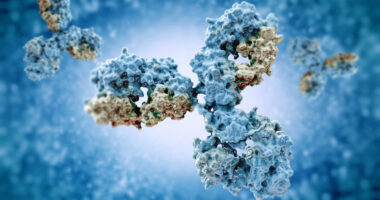Risk of Inhibitor Development Tied to High BAFF Protein Levels

Elevated levels of the immune signaling protein BAFF were found in the bloodstream of boys who developed neutralizing antibodies against FVIII replacement therapy, a standard treatment in hemophilia A, a study reported for the first time.
Changes in the gene that encodes the BAFF protein, involved in the growth of antibody-producing B-cells, were also associated with inhibitor development.
According to researchers, the findings suggest that these genetic changes may be an independent risk factor for generating inhibitors and that BAFF levels may be a helpful biomarker to predict inhibitor development in newly diagnosed hemophilia A children.
The study, “BAFF rs9514828 gene polymorphism and the risk of the development of inhibitors in children with severe haemophilia A,” was published in Haemophilia.
Hemophilia A is a disease caused by a deficiency in a blood clotting protein called factor VIII (FVIII). Replacement therapy with FVIII — a type of treatment that involves administering a version of the missing FVIII — is one of the standard therapies used to treat hemophilia A.
The treatment’s main complication is the development of neutralizing antibodies, called inhibitors, against the infused FVIII, which can occur in up to 30% of patients. These inhibitors render replacement therapy ineffective and are the leading cause of hemophilia-related morbidity and mortality.
The underlying cause of developing inhibitors appears to involve both environmental and genetic risk factors.
Environmental factors include the type of FVIII administrated, the age at first exposure to FVIII replacement, and treatment intensity. Genetic risk factors include the type and severity of hemophilia, the type of mutation in the F8 gene that encodes for FVIII, family history, ethnicity, and genetic variation in genes for immune system-related proteins.
An immune signaling protein, or cytokine, called B-cell activating factor (BAFF), has been implicated in the survival and maturation of a subset of antibody-producing B-cells. A recent study found BAFF levels were significantly higher in the bloodstream of hemophilia patients with inhibitors than in those without inhibitors, suggesting that BAFF might be associated with developing inhibitors.
However, there is no available data about a possible relationship between variations in the gene that encodes for BAFF — referred to as gene polymorphisms — and the risk of inhibitor development.
Researchers at Tanta University in Egypt recruited 100 boys newly diagnosed with severe hemophilia A who had not previously received FVIII replacement therapy.
The team measured BAFF blood levels and performed genetic testing at first diagnosis, and patients were followed until they completed 50 exposure days to FVIII, or until they developed inhibitors, whichever occurred first.
Among the participants, 29 (29%) tested positive for inhibitors after a mean of 26.2 days of exposure to FVIII. From these, 24 had high levels (titers) of inhibitor antibodies.
Family history for inhibitors was seen in 44.8% of inhibitor-positive patients compared to 22.5% of inhibitor-negative patients. There were no differences in ethnicity, age at first FVIII infusion, or treatment regimen between those with and without inhibitors.
Genetic analysis found statistically significant differences between inhibitor-positive and negative patients. Those with inhibitors more frequently carried the BAFF risk variant rs9514828 (T) — associated with increased gene activity, higher BAFF levels, and abnormal antibodies found in the autoimmune conditions lupus and Sjogren’s syndrome.
The risk variant BAFF rs9514828 (CT) was associated with a 3.6-times higher risk of inhibitor development, the rs9514828 (TT) variant with a 2.4-times higher risk, and the rs9514828 (CT + TT) variant with a 3.4-times higher risk. Of note, C refers to cytosine, and T to thymine, two DNA building blocks that are changed in these particular BAFF variants.
These findings suggest that “BAFF rs9514828 polymorphism could be an independent risk factor for the development of FVIII inhibitors,” the team wrote.
At the same time, BAFF levels were confirmed to be significantly higher in the bloodstream of inhibitor-positive patients compared with inhibitor-negative patients, “suggesting the pathogenic [disease-causing] role of BAFF in the development of FVIII inhibitors,” they wrote.
These BAFF rs9514828 changes were significantly associated with both FVIII inhibitor and BAFF levels. Moreover, high BAFF levels were associated with high FVIII antibody levels.
BAFF levels were shown to be able to predict the development of inhibitors with an 84.4% accuracy, a sensitivity (ability to correctly identify those with inhibitors) of 85.9%, and a specificity (ability to correctly identify those without inhibitors) of 80.2%.
“BAFF rs9514828 gene polymorphism could be [an] independent risk factor and elevated BAFF levels might be [a] useful independent prognostic [predictive] marker for FVIII inhibitor development in newly diagnosed children with severe [hemophilia A],” the researchers wrote.







